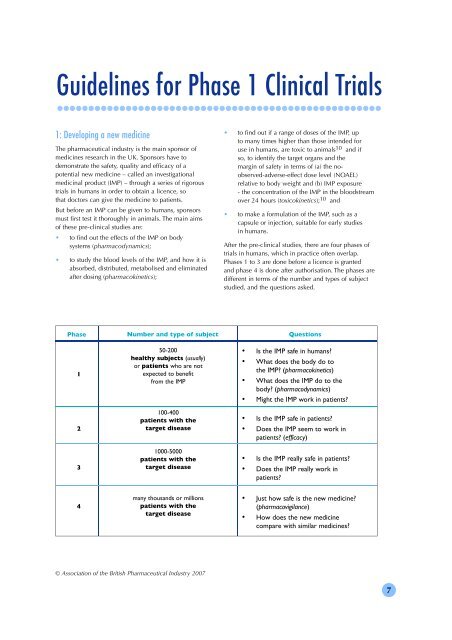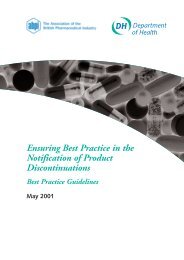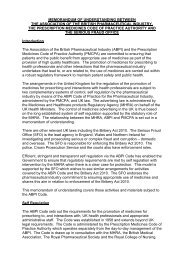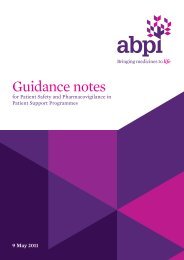ABPI Guidelines for Phase 1 Clinical Trials (PDF
ABPI Guidelines for Phase 1 Clinical Trials (PDF
ABPI Guidelines for Phase 1 Clinical Trials (PDF
Create successful ePaper yourself
Turn your PDF publications into a flip-book with our unique Google optimized e-Paper software.
<strong>Guidelines</strong> <strong>for</strong> <strong>Phase</strong> 1 <strong>Clinical</strong> <strong>Trials</strong><br />
• • • • • • • • • • • • • • • • • • • • • • • • • • • • • • • • • • • • • • • • • • • • • • • • • • • •<br />
1: Developing a new medicine<br />
The pharmaceutical industry is the main sponsor of<br />
medicines research in the UK. Sponsors have to<br />
demonstrate the safety, quality and efficacy of a<br />
potential new medicine – called an investigational<br />
medicinal product (IMP) – through a series of rigorous<br />
trials in humans in order to obtain a licence, so<br />
that doctors can give the medicine to patients.<br />
But be<strong>for</strong>e an IMP can be given to humans, sponsors<br />
must first test it thoroughly in animals. The main aims<br />
of these pre-clinical studies are:<br />
• to find out the effects of the IMP on body<br />
systems (pharmacodynamics);<br />
• to study the blood levels of the IMP, and how it is<br />
absorbed, distributed, metabolised and eliminated<br />
after dosing (pharmacokinetics);<br />
50-200<br />
healthy subjects (usually)<br />
or patients who are not<br />
expected to benefit<br />
from the IMP<br />
100-400<br />
patients with the<br />
target disease<br />
1000-5000<br />
patients with the<br />
target disease<br />
many thousands or millions<br />
patients with the<br />
target disease<br />
© Association of the British Pharmaceutical Industry 2007<br />
• to find out if a range of doses of the IMP, up<br />
to many times higher than those intended <strong>for</strong><br />
use in humans, are toxic to animals 10 and if<br />
so, to identify the target organs and the<br />
margin of safety in terms of (a) the noobserved-adverse-effect<br />
dose level (NOAEL)<br />
relative to body weight and (b) IMP exposure<br />
- the concentration of the IMP in the bloodstream<br />
over 24 hours (toxicokinetics); 10 and<br />
• to make a <strong>for</strong>mulation of the IMP, such as a<br />
capsule or injection, suitable <strong>for</strong> early studies<br />
in humans.<br />
After the pre-clinical studies, there are four phases of<br />
trials in humans, which in practice often overlap.<br />
<strong>Phase</strong>s 1 to 3 are done be<strong>for</strong>e a licence is granted<br />
and phase 4 is done after authorisation. The phases are<br />
different in terms of the number and types of subject<br />
studied, and the questions asked.<br />
<strong>Phase</strong> Number and type of subject Questions<br />
1<br />
2<br />
3<br />
4<br />
• Is the IMP safe in humans?<br />
• What does the body do to<br />
the IMP? (pharmacokinetics)<br />
• What does the IMP do to the<br />
body? (pharmacodynamics)<br />
• Might the IMP work in patients?<br />
• Is the IMP safe in patients?<br />
• Does the IMP seem to work in<br />
patients? (efficacy)<br />
• Is the IMP really safe in patients?<br />
• Does the IMP really work in<br />
patients?<br />
• Just how safe is the new medicine?<br />
(pharmacovigilance)<br />
• How does the new medicine<br />
compare with similar medicines?<br />
7









